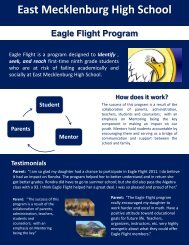Introduction to MIL1
You also want an ePaper? Increase the reach of your titles
YUMPU automatically turns print PDFs into web optimized ePapers that Google loves.
INTRODUCTION:<br />
MEDIA & INFORMATION LITERACY
MEDIA LITERACY<br />
• is the ability <strong>to</strong> access, analyze, evaluate, and create media. The word media refers <strong>to</strong> the<br />
different means of communication, such as television, radio, newspapers, magazines, and<br />
the Internet.
MEDIA LITERACY:<br />
Importance<br />
a) Media literacy exercises critical thinking when analyzing different forms of media;<br />
b) Effectively engages students <strong>to</strong> apply critical thinking skills <strong>to</strong> a wide range of issues;<br />
c) Allows one <strong>to</strong> discern what information is factual, truthful, and objective through critical<br />
thinking;<br />
d) Enables students <strong>to</strong> become competent in processing and assessing the form of media. A<br />
media literate person is able <strong>to</strong> think independently and makes his own opinion instead<br />
of relying on what the media dictates; and<br />
e) Makes students well informed in using the different forms of mass media<br />
simultaneously. (using intellectual and artistic sense in creating useful and effective<br />
forms of media)
INFORMATION LITERACY<br />
• is the skill that allows a person <strong>to</strong> recognize when information is needed and how he will<br />
be able <strong>to</strong> access, locate, evaluate, and use it effectively.<br />
• Importance of Information Literacy: (a) lets you distinguish which among the<br />
sources of information are relevant; (b) allows you <strong>to</strong> organize and classify the different<br />
forms of media which can be used <strong>to</strong> secure relevant and substantial information; (c)<br />
develops effective research skills essential in enriching knowledge and enhancing<br />
comprehension; and (d) involves all disciplines and all levels of education (through it, one<br />
is able <strong>to</strong> gather essential information and utilize this essential information <strong>to</strong> expand<br />
knowledge).
TECHNOLOGY LITERACY<br />
• is the ability <strong>to</strong> acquire relevant information and use modern-day <strong>to</strong>ols <strong>to</strong> get, manage,<br />
apply, evaluate, create, and communicate information.<br />
• Importance of Technology Literacy: (a) Past and present technologies both provide<br />
convenience and efficiency; (b) Technology is associated with machines, equipment, device,<br />
or any invention that show advancement in scientific knowledge, engineering, and<br />
computer concepts; and (c) With technological discoveries and breakthroughs, people<br />
nowadays are even hoping <strong>to</strong> find cure for dreaded incurable illnesses, like brain cancer.
CREATORS OF MEDIA AND INFORMATION<br />
• Writers and journalists. Their primary role is <strong>to</strong> translate relevant and meaningful information in<strong>to</strong> printed<br />
materials, such as books, newspapers, and magazines.<br />
• Edi<strong>to</strong>rs. Writers and journalists work hand in hand with edi<strong>to</strong>rs <strong>to</strong> ensure that the manuscript or articles<br />
submitted by the former are high in standard and are fit <strong>to</strong> print. They make sure that the material <strong>to</strong> be<br />
published is free from factual and grammatical errors.<br />
• Direc<strong>to</strong>rs. Also known as filmmakers, direc<strong>to</strong>rs create movies, shows, programs, or plays that are seen on<br />
theaters or television channels and see <strong>to</strong> it that the message of the show is made clear <strong>to</strong> the audience.<br />
• Performers. They portray the characters in movies, shows, or plays. Other performers are singers and<br />
dancers who express their creativity and inner thoughts through their craft.<br />
• Visual Artists. Paintings and sculptures are some of the masterpieces that visual artists create <strong>to</strong> express a<br />
message or their deeper thoughts.
CHARACTERISTICS OF A GOOD MEDIA<br />
PRACTITIONER<br />
• Truthfulness. Media practitioners should convey a message or information that is<br />
accurate, factual, and truthful. Erroneous or false information can harm the reputation of<br />
others or it may cause them danger.<br />
• Fairness and objectivity. The information or message disseminated by media<br />
practitioners should be objective and based on grounded evidence. If information is<br />
biased or opinionated, it will deceive the public of the truth.<br />
• Responsibility and integrity. Media practitioners are expected <strong>to</strong> show<br />
professionalism regardless of the situation they are in. They should possess a sense of<br />
responsibility and accountability when acquiring and communicating information.
TYPES OF MEDIA<br />
• Print media (Book e.g. reference books such as almanac, dictionary, thesaurus, and<br />
atlas, newspaper, magazine, leaflet, flyer, etc.)<br />
• Broadcast Media (Radio, Television, Film)<br />
• New Media (Internet)-- Web page, Hypertext, Instant Messaging, E-mail,<br />
Distance Education, E-books, Online shopping, Media Convergence (modes of connection<br />
like broadband, cable and Wi-Fi)
CHARACTERISTICS OF A GOOD MEDIA<br />
PRACTITIONER<br />
• Empathy and sympathy. Media practitioners empathize when they put themselves in<br />
the shoes of those who are in need and sympathize when they feel the sorrow of those<br />
who experience adversities. Thus, they should be sensitive <strong>to</strong> the needs of others.<br />
• Hard working. The public depends on the information media practitioners deliver that<br />
is why they are expected <strong>to</strong> work hard in sourcing accurate information. The public<br />
regards media practitioners highly, so they must not compromise the public’s interest.
ADVANTAGES OF A MEDIA AND INFORMATION<br />
LITERATE INDIVIDUAL<br />
1. Improved quality of life<br />
2. Greater political participation<br />
3. Better economic opportunities<br />
4. Improved learning environment<br />
5. More cohesive social units



